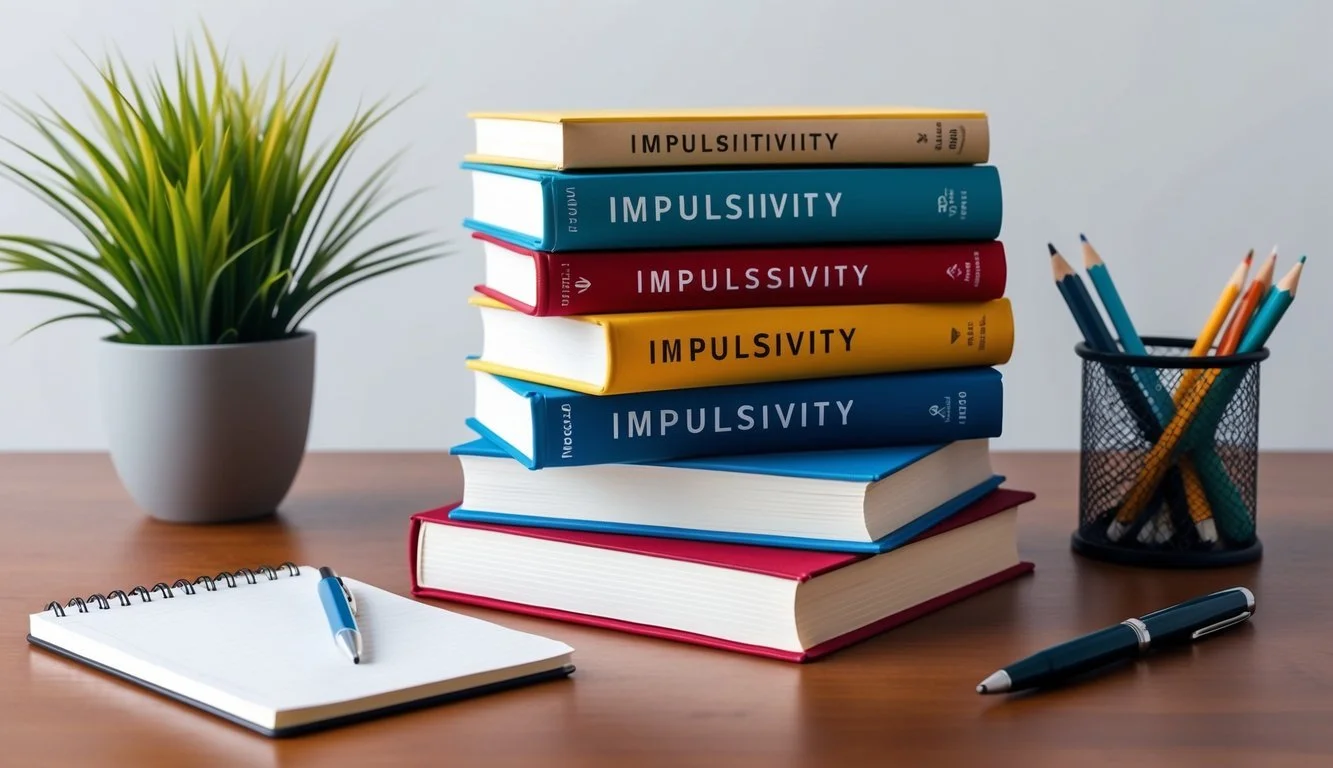Top Books on Impulsivity: Strategies for Better Self-Control and Decision-Making
Books on impulsivity offer valuable insights into managing impulsive behaviors and developing better self-control. These works explore the psychological, social, and economic aspects of impulsivity, providing readers with practical strategies to improve their decision-making processes.
Several books focus on specific types of impulsive behaviors, such as shopping addictions or impulse control disorders, while others take a broader approach to the topic. For example, "Stop Me Because I Can't Stop Myself" addresses four specific impulsive behaviors, while other titles offer more generalized advice on handling impulsivity in various situations.
Popular books in this genre include "Impulsive Ninja," part of the Ninja Life Hacks series, which targets children and provides social-emotional lessons on impulse control for school and home settings. Daniel Kahneman's "Thinking, Fast and Slow" presents a comprehensive analysis of two modes of thought: the fast, instinctive System 1 and the slower, more deliberative System 2, offering readers a deeper understanding of cognitive biases and decision-making processes.
Understanding Impulsivity
Impulsivity involves acting quickly without adequate forethought or consideration of consequences. It stems from complex interactions between psychological factors and neurobiological mechanisms.
The Psychology of Impulsivity
Impulsivity manifests as a tendency to act on immediate urges without planning. It can lead to risky behaviors and difficulty with self-control. Psychologists categorize impulsivity into multiple dimensions:
Motor impulsivity: Acting without thinking
Attentional impulsivity: Difficulty focusing or persisting on tasks
Non-planning impulsivity: Lack of forethought or future planning
Impulsive individuals often seek novelty and excitement. They may struggle with delayed gratification, preferring smaller immediate rewards over larger delayed ones.
Cognitive-behavioral techniques can help manage impulsive tendencies. These include:
• Mindfulness practices • Impulse control strategies • Cognitive restructuring
Neurobiological Aspects of Impulsive Behavior
Brain imaging studies reveal impulsivity involves multiple neural networks. Key areas include the prefrontal cortex, which regulates behavior, and the limbic system, responsible for emotion and motivation.
Neurotransmitters play a crucial role in impulsive actions. Dopamine influences reward-seeking behavior, while serotonin affects inhibition and self-control. Imbalances in these chemicals may contribute to heightened impulsivity.
Genetic factors also impact impulsivity. Variations in genes related to dopamine and serotonin function can predispose individuals to more impulsive traits.
Environmental factors like stress or substance use can temporarily increase impulsivity by altering brain function.
Impulsivity in Literature
Impulsivity features prominently in various literary works, offering insights into human behavior and its consequences. Authors explore this trait through fictional characters and personal accounts, shedding light on its complexities.
Portrayals in Fiction
Fictional narratives often depict impulsive characters to drive plot and explore psychological themes. In F. Scott Fitzgerald's "The Great Gatsby," Jay Gatsby's impulsive pursuit of Daisy Buchanan leads to his downfall. Dostoyevsky's "Crime and Punishment" examines the aftermath of Raskolnikov's impulsive murder.
Modern novels like "The Girl on the Train" by Paula Hawkins use impulsivity to create suspense and unreliable narrators. Young adult literature, such as "The Perks of Being a Wallflower" by Stephen Chbosky, portrays impulsive teenage behavior and its impact on relationships.
Autobiographical Accounts
Many authors have shared personal experiences with impulsivity in memoirs and autobiographies. Augusten Burroughs' "Running with Scissors" recounts his impulsive childhood decisions and their long-term effects. Kay Redfield Jamison's "An Unquiet Mind" offers a clinical psychologist's perspective on bipolar disorder and impulsive behavior.
Carrie Fisher's "Wishful Drinking" humorously addresses her struggles with addiction and impulsive actions. These real-life accounts provide readers with authentic insights into living with and managing impulsivity, often offering hope and coping strategies.
Assessing and Measuring Impulsivity
Accurate assessment of impulsivity is crucial for understanding and addressing impulsive behaviors. Researchers and clinicians utilize various psychometric scales and behavioral methods to quantify and evaluate impulsivity in individuals.
Psychometric Scales
Psychometric scales provide standardized measures of impulsivity through self-report questionnaires. The Barratt Impulsiveness Scale (BIS-11) is widely used, assessing motor, attentional, and non-planning impulsiveness. It contains 30 items rated on a 4-point scale.
The UPPS-P Impulsive Behavior Scale examines five facets of impulsivity: negative urgency, lack of premeditation, lack of perseverance, sensation seeking, and positive urgency. This 59-item measure offers a comprehensive view of impulsive traits.
For children and adolescents, the Eysenck Junior Impulsiveness Scale provides age-appropriate assessment. It includes 23 yes/no questions targeting impulsive tendencies in younger populations.
Behavioral Assessment Methods
Behavioral tasks offer objective measures of impulsive actions. The Go/No-Go task evaluates response inhibition by requiring participants to respond quickly to "Go" stimuli while withholding responses to "No-Go" stimuli.
The Iowa Gambling Task assesses decision-making and risk-taking. Participants choose cards from four decks, with some decks leading to long-term gains and others to losses. Impulsive individuals often prefer immediate rewards despite negative consequences.
The Delay Discounting Task measures preference for smaller immediate rewards versus larger delayed rewards. Participants choose between options like "$10 now" or "$50 in a month." Steep discounting of future rewards indicates higher impulsivity.
Impulsivity Across the Lifespan
Impulsivity manifests differently at various stages of human development. Age-related changes in brain structure and function influence impulse control abilities throughout life.
Developmental Perspectives
Impulsivity tends to peak during adolescence. Teens often exhibit risk-taking behaviors and struggle with self-regulation due to ongoing brain development. The prefrontal cortex, responsible for impulse control, is not fully mature until the mid-20s.
Young children typically display high impulsivity as they learn to control their actions and emotions. Parental guidance and environmental factors play crucial roles in shaping impulse control during early childhood.
As individuals enter adulthood, impulse control generally improves. However, some may continue to struggle with impulsive behaviors.
Impulsivity in Adult Populations
Adults face unique challenges related to impulsivity. Career pressures, financial responsibilities, and relationship dynamics can influence impulse control.
Some adult populations are more prone to impulsive behaviors:
Individuals with ADHD
Those struggling with substance abuse
People experiencing high stress levels
Aging can affect impulse control in complex ways. While some older adults may show improved self-regulation, others might experience declines in impulse control due to cognitive changes.
Strategies for managing adult impulsivity include:
Mindfulness practices
Cognitive-behavioral therapy
Medication (in some cases)
Understanding how impulsivity changes across the lifespan can help individuals and healthcare providers develop targeted interventions and coping mechanisms.
Clinical Approaches to Impulsivity
Clinical approaches to managing impulsivity focus on both psychological and pharmacological interventions. These methods aim to help individuals develop better impulse control and reduce problematic behaviors.
Cognitive Behavioral Therapy
Cognitive Behavioral Therapy (CBT) is a widely used psychological treatment for impulsivity. This approach helps patients identify triggers and thought patterns that lead to impulsive actions.
CBT teaches specific techniques to pause and reflect before acting. These may include:
Self-monitoring strategies
Cognitive restructuring
Therapists work with clients to develop personalized coping skills and alternative behaviors. CBT often incorporates role-playing and real-world practice to reinforce new habits.
Studies have shown CBT can be effective in reducing impulsivity across various disorders, including ADHD and substance abuse.
Pharmacological Treatments
Medication can play a crucial role in managing impulsivity, especially when it stems from underlying neurological conditions. Common pharmacological approaches include:
Stimulants: Often prescribed for ADHD, these medications can improve focus and reduce impulsive behaviors.
Selective Serotonin Reuptake Inhibitors (SSRIs): These antidepressants may help with impulsivity related to mood disorders or obsessive-compulsive tendencies.
Mood stabilizers: Used to treat bipolar disorder, these can help regulate emotional fluctuations that contribute to impulsive actions.
Antipsychotics: In some cases, these medications may be prescribed to address severe impulsivity associated with certain psychiatric conditions.
The choice of medication depends on the underlying cause of impulsivity and individual patient factors. Regular monitoring and dosage adjustments are crucial for optimal results.
Impulsivity in Various Disorders
Impulsivity manifests differently across several mental health conditions. It plays a central role in the symptoms and behaviors associated with ADHD, substance use disorders, and certain personality disorders.
Attention-Deficit/Hyperactivity Disorder (ADHD)
Impulsivity is a core symptom of ADHD. Individuals with ADHD often struggle with inhibiting responses and delaying gratification. This can lead to:
Interrupting others in conversations
Making rash decisions without considering consequences
Difficulty waiting for their turn in activities or games
Acting without thinking in potentially dangerous situations
Treatment for ADHD-related impulsivity typically involves a combination of medication (such as stimulants) and behavioral therapy. These interventions aim to improve impulse control and enhance executive functioning.
Substance Use Disorders
Impulsivity is both a risk factor for and a consequence of substance abuse. People with higher baseline impulsivity are more likely to:
Experiment with drugs or alcohol
Engage in binge drinking or drug use
Struggle with maintaining abstinence during recovery
Chronic substance use can further impair impulse control, creating a vicious cycle. Treatment approaches for substance use disorders often focus on:
Cognitive-behavioral strategies to manage impulsive urges
Mindfulness techniques to increase self-awareness
Medications to reduce cravings and impulsive drug-seeking behavior
Personality Disorders
Impulsivity is a key feature in several personality disorders, particularly Borderline Personality Disorder (BPD) and Antisocial Personality Disorder (ASPD).
In BPD, impulsivity often manifests as:
Reckless spending
Unsafe sexual behavior
Self-harm or suicidal gestures
Individuals with ASPD may display impulsivity through:
Aggressive outbursts
Frequent job changes or relocations
Illegal activities without concern for consequences
Treatment for personality disorders with impulsive features typically involves long-term psychotherapy. Dialectical Behavior Therapy (DBT) has shown particular effectiveness for BPD, helping individuals develop skills to manage impulsive urges and regulate emotions.
Social and Cultural Dimensions of Impulsivity
Impulsivity manifests differently across social contexts and cultures. Social norms and cultural values shape attitudes toward impulsive behaviors and influence decision-making processes.
Social Influences on Impulsive Behavior
Social environments play a crucial role in shaping impulsive tendencies. Peer groups can either encourage or discourage impulsive actions. In adolescence, the presence of peers often increases risk-taking behaviors.
Family dynamics also impact impulsivity. Parenting styles that are overly permissive or authoritarian may contribute to higher levels of impulsive behavior in children.
Socioeconomic factors influence impulsivity as well. Studies have shown that individuals from lower-income backgrounds may exhibit more impulsive decision-making, particularly in financial matters.
Cultural Attitudes Towards Impulsivity
Cultural norms significantly affect perceptions of impulsivity. Western cultures often value spontaneity and quick decision-making, sometimes viewing impulsivity as a positive trait.
In contrast, many Eastern cultures prioritize self-control and deliberation. These societies may view impulsive behavior more negatively.
Risk-taking attitudes vary across cultures. Some societies encourage calculated risks in business or innovation, while others emphasize caution and stability.
Cultural differences in time perception also influence impulsivity. Cultures with a more future-oriented outlook may exhibit less impulsive behavior compared to those focused on immediate gratification.
Impulsivity and Decision-Making
Impulsivity significantly impacts decision-making processes, affecting both short-term choices and long-term outcomes. It often leads to risk-taking behaviors and can have lasting consequences on various aspects of life.
Risk-Taking Behaviors
Impulsive individuals tend to engage in more risky activities without fully considering potential outcomes. This can manifest in financial decisions, such as making hasty investments or excessive gambling. In social situations, impulsivity may lead to reckless behavior, including substance abuse or unsafe sexual practices.
Research shows that impulsive decision-makers often underestimate risks and overestimate potential rewards. This skewed perception can result in a pattern of choices that prioritize immediate gratification over long-term benefits.
Long-Term Consequences of Impulsive Decisions
Repeated impulsive decisions can have far-reaching effects on an individual's life. In academic or professional settings, impulsivity may lead to poor performance, missed opportunities, or career setbacks. Financially, it can result in debt, bankruptcy, or unstable economic situations.
Impulsive choices in personal relationships may cause conflicts, breakups, or difficulty maintaining long-term commitments. Health-wise, impulsive eating habits or neglect of medical advice can lead to chronic conditions or exacerbate existing health issues.
Developing self-control strategies and seeking professional help can mitigate these long-term consequences. Cognitive-behavioral techniques and mindfulness practices have shown promise in helping individuals manage impulsive tendencies and make more balanced decisions.
Strategies for Managing Impulsivity
Effective techniques can help individuals control impulsive behaviors and make more thoughtful decisions. These approaches focus on developing self-awareness, regulating emotions, and enhancing decision-making skills.
Mindfulness and Self-Control Techniques
Mindfulness practices play a crucial role in managing impulsivity. By cultivating present-moment awareness, individuals can observe their thoughts and urges without immediately acting on them. This pause allows for more considered responses.
Deep breathing exercises can quickly calm the nervous system, reducing the likelihood of impulsive reactions. Counting to ten before making decisions gives time for rational thought to override impulses.
The 48-hour rule is an effective strategy for major decisions. It involves waiting two days before acting on non-urgent impulses, allowing time for careful consideration.
Regular meditation strengthens the brain's ability to resist impulses and improves emotional regulation. Even short daily sessions can yield significant benefits over time.
Educational and Preventive Programs
Cognitive Behavioral Therapy (CBT) is a proven approach for addressing impulsivity. It helps individuals identify triggers, challenge unhelpful thoughts, and develop healthier response patterns.
Dialectical Behavior Therapy (DBT) offers specific skills for managing impulsive behaviors. It emphasizes mindfulness, distress tolerance, and interpersonal effectiveness.
Impulse control workshops teach practical strategies for delaying gratification and improving decision-making. These programs often include role-playing exercises to practice new skills.
Self-awareness training helps people recognize their impulsive tendencies. Participants learn to identify personal triggers and early warning signs of impulsive behavior.
Stress management programs equip individuals with tools to handle pressure without resorting to impulsive actions. Techniques may include progressive muscle relaxation and guided imagery.
Research and Future Directions
Recent studies on impulsivity have sparked new treatment approaches and areas of investigation. Researchers are exploring neurobiological mechanisms and developing targeted interventions.
Emerging Studies on Impulsivity
Neuroscience has revealed key brain regions involved in impulsive behaviors. The prefrontal cortex, striatum, and amygdala play crucial roles in impulse control. Neuroimaging studies have identified altered activity in these areas among individuals with high impulsivity.
Genetic research has uncovered several genes linked to impulsive traits. Variations in dopamine and serotonin-related genes appear particularly influential. Epigenetic factors are also under investigation for their potential impact on impulse control.
Longitudinal studies are tracking the development of impulsivity across the lifespan. Early childhood experiences and environmental factors are being examined for their effects on impulsive tendencies later in life.
Innovations in Treatment Approaches
Cognitive-behavioral therapy remains a cornerstone treatment for impulsivity. New adaptations incorporate mindfulness techniques to enhance self-awareness and emotional regulation. Virtual reality programs allow patients to practice impulse control in simulated environments.
Pharmacological interventions continue to evolve. Selective serotonin reuptake inhibitors show promise for certain impulsive behaviors. Novel compounds targeting specific neurotransmitter systems are in clinical trials.
Neurofeedback and transcranial magnetic stimulation offer non-invasive options for modulating brain activity. These techniques aim to strengthen neural circuits involved in self-control. Preliminary results are encouraging, but larger studies are needed to confirm efficacy.








